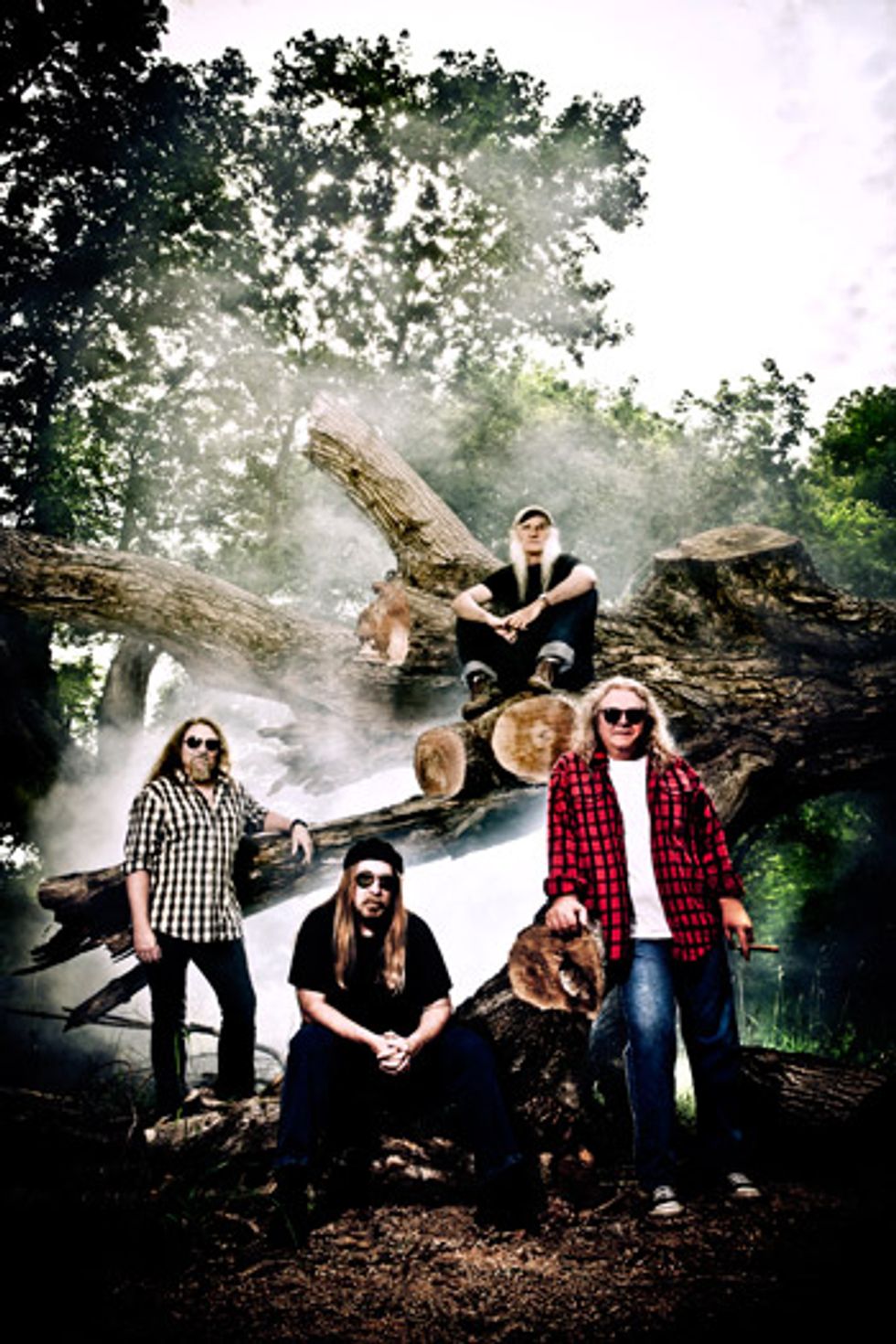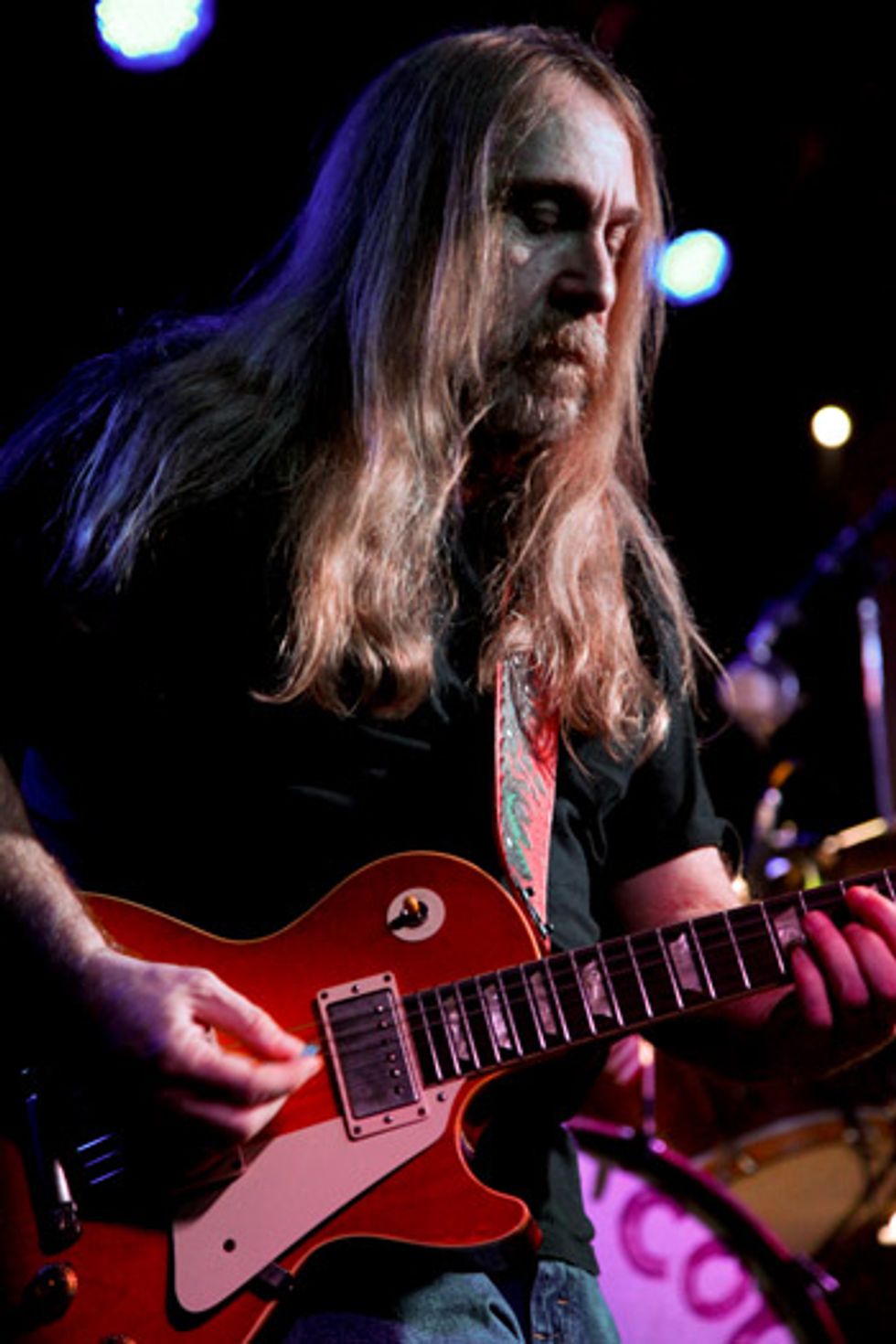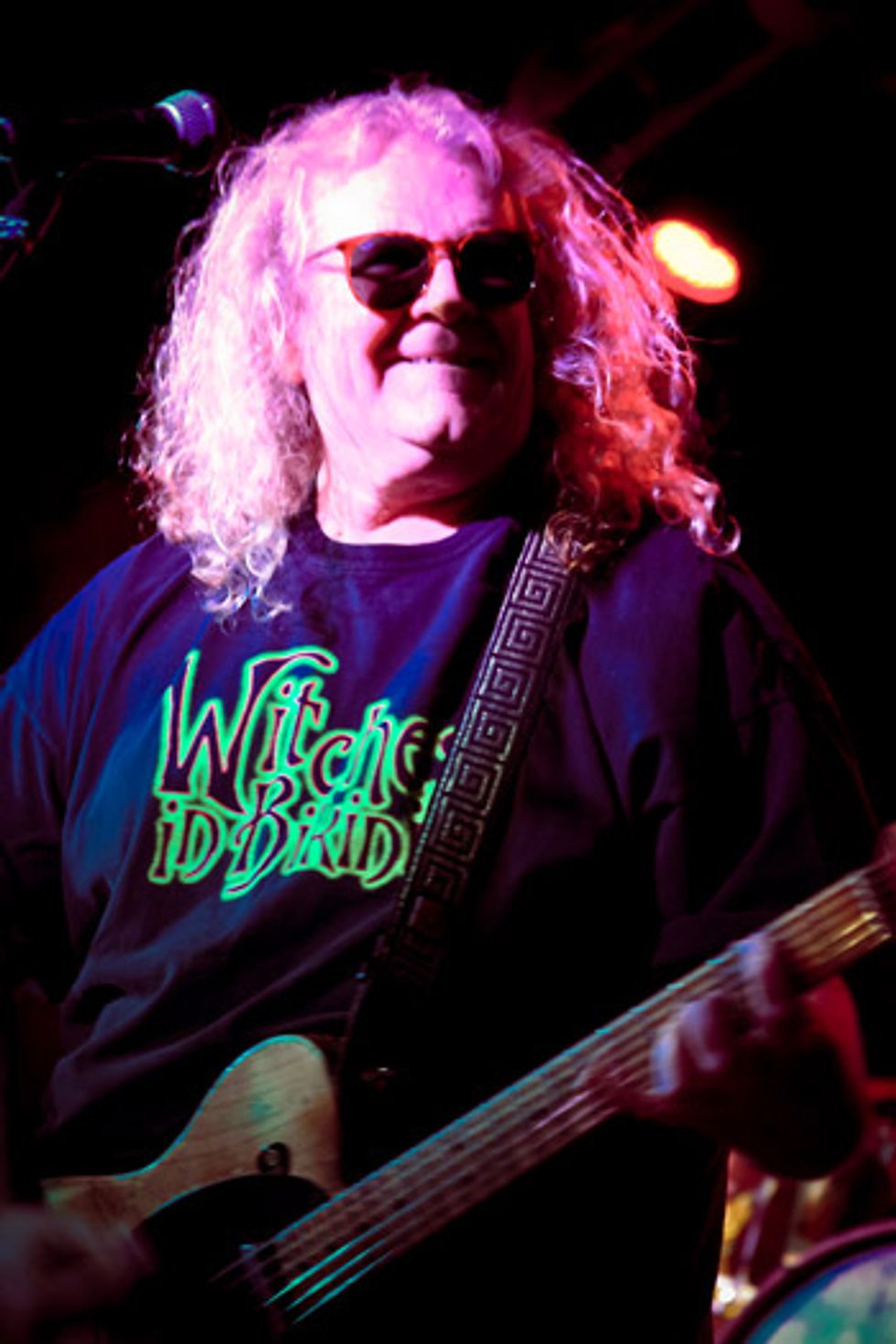Richard Young and Greg Martin talk “Dixie Lullabies” and gear.

“It’s magic, man,” says Richard Young, vocalist and rhythm guitarist for The Kentucky Headhunters, referring to the Practice House, an old farmhouse he inherited from his grandmother. This humble abode, which sits out on a creek, is where the Southern rockers have written about 90 percent of their songs, going back to 1968, when they were known as Itchy Brother until they became the Kentucky Headhunters in 1986. Young says, “It’s a farmhouse. To look at it from the outside you’d go, ‘That’s where they do this?’ But when you walk inside and turn the lights on, it transforms into this psychedelic shack and has a funky guru mojo.” Virtually all of the Kentucky Headhunters material, including the group’s 1989 album Pickin’ on Nashville, which scored the band a Grammy for Best Country Performance by a Duo or Group with Vocal and put them on the map, was conceived and rehearsed at the Practice House. Surprisingly they’ve never recorded there—until now.
Dixie Lullabies, The Kentucky Headhunters latest release, is the first album the band has recorded at the Practice House. “Originally we were thinking about going back to Nashville to do this album,” says lead guitarist Greg Martin. “About this time last year, we did some dates with Jamey Johnson and his rhythm guitarist, Wade Battle, had written a song with Richard. He came to the Practice House and was amazed by the history, the acoustics, and just the vibe of it, and offered to work with us. About the day after Christmas, Wade brought up Pro Tools and some microphones. We always thought it was a great idea to record there because that’s where most of our music came together.” And with that, the floodgates opened for the Headhunters’ future endeavors. “I doubt very seriously we’ll ever do another album in a big studio because we’ve kind of come full circle,” Young says. “We always wanted to record here since we were kids.”
We caught up with Young and Martin, a bona fide tone freak—there’s a song called “Les Paul Standard” on the new album and Gibson will be releasing a limited run of Greg Martin signature models, if that tells you anything—to get the scoop on Dixie Lullabies and talk gear.
Why did it take so long between Dixie Lullabies and the last album of originals, 2003’s Soul?
Martin: We were a five-piece band at the time and then we did another album in 2005, Big Boss Man, but that was cover material. Anthony Kenney (bass player from 1992) left the band sometime around 2007 and we had to get our bearings together as a four-piece band. The first year or two we were just out there redeveloping and redefining our sound.
Greg Martin’s Gearbox
Guitars
1958 sunburst Gibson Les Paul Standard w/ PAFs, 1957 Fender Stratocaster, 1963 Les Paul SG Standard, Gibson Acoustics, 2011 Gibson Les Paul Standard (Greg Martin prototype No. 1), 1955 Gibson Les Paul Goldtop Standard w/P90s, 1956 Gibson Les Paul Jr. (open-D tuning), 2006 Dan Armstrong Plexi (clear acrylic)
Amps
1969 Marshall Super Lead 100-watt head (with two EL34 power tubes pulled),
Two 1971 Marshall 4x12 cabinets with 30-watt Celestion Greenback speakers
Strings
D’Addario .010s
Straps
Zebo
Slides
Rocky Martin Slides Swamp Frog
Richard Young’s Gearbox
Guitars
1952 Fender Telecaster “Danny,” 1958 Gibson Les Paul Jr. double cut-away, 1963 Fender Telecaster, 1959 Guild acoustic, 1938 Gibson L-OO
Amps
Fender Bassman reissue with Eminence speakers, 1957 Fender tweed Deluxe
Strings
D’Addario .011s
Straps
Ace
What brought about the new album?
Young: It was all about the way the air felt, man. When we started out, we wanted to be the biggest English rock band in Kentucky, in America, in the world. Even though we’re a Southern rock band, obviously, we had our success through country music. When you see guys like Robert Plant coming out and you see the Zac Brown Band in country music then you start to realize that these things are being accepted. We’ve been watching for the past few years.
So the timing was right.
Young: Yeah, the timing was right. Also we’ve had something great happen in our family. My son has this band, Black Stone Cherry, and I was instrumental in helping them get started. They also work in the Practice House.
Do you guys get exposed to a new audience through Black Stone Cherry?
Young: Yeah. It brings an audience to us and then through that curiosity they start listening. A kid from London who reviews records said, “You know, I picked up this Headhunters record because of Black Stone Cherry and I gotta tell you I was blown away.” It made me feel good that our music is still viable even with young rock audiences.
Are you aiming for a new fan base or is this record for your loyal following?
Young: We always call it our baby Grateful Dead following, although it’s by no means that feverish or that large of an audience. But it’s people that started with us, that stayed with us, and all of a sudden their children start liking us.
Let’s talk about some songs from the album. “Tumbling Roses” is a great one with really tasty guitar work throughout.
Martin: Well thank you. That’s my favorite track; I really love that song. The guitar work I’m doing on that one is almost like soul guitar. It’s coming from Muscle Shoals and Stax and it sounds a whole lot like the Stones on Some Girls.
Young: That’s a song that I really enjoyed writing and singing. Doing that song live, you can tell that the minute we kick into it that it transcends into something. That’s when you know you’ve got a good one.
“Recollection Blues” has a jazzy vibe. Tell us about that.
Young: I think I wrote the chord structure for that one on an old ’53 ES-125 because it got me in that mood. A couple of years ago I really got into Billie Holiday and Django Reinhardt and then I started dabbling and found out about these other guys like, Eddie Lang.
“Recollection Blues” was the last thing we recorded and it was cold that night, like 10 below zero. We tracked that whole song in one take and they said there was a cloud of steam around my head while I was singing. We had the lights out and some candles burning and it was such a great atmosphere.
Martin: I was thinking of Les Paul [the guitarist] on that one. I have this little descending run [sings lick].
You mean that super-long, single-string descending legato lick in your solo?
Martin: Yeah. Originally I heard that from Jeff Beck. I love Beck because he can do anything. But I heard him do things like that on live recordings and about four or five years ago I started listening to a lot of Les Paul and Chet Atkins a lot, and those guys do a lot of those little quirky things like that.

What did you use for the lush reverb on that one?
Martin: Oddly enough, the reverb was added in during the mixdown process.
Tell us about your guitars.
Young: My ’52 Tele is called Danny, named after Danny Gatton. When we first hit we were going down to Texas and our manager at the time was working with Danny. We loved him and took him to South Texas with us. He played a kind of Rockabilly that folks down on the border really dug. I’d just gotten this Tele a week before somewhere in Texas and Danny was at a sound check and he said, “Leave that guitar with me this afternoon and instead of making it sound like a Tele, I’ll make it sound like the devil.” I came back and he had bent my toggle switch the way he had bent his. I was upset and said, “Danny what are you doing man? It’s a ’52 Tele.” And he said, “Trust me, that’s the only way you can play a Tele.” So anyway I wouldn’t touch anything except that toggle switch now of course. This Tele is one of a kind.
When he bent the toggle switch, what did that do?
Young: You know how, on a Stratocaster, when you play you’re always knocking the toggle switch down? I can’t play one without taping the toggle switch where I want it. I found out that when you play a Tele you almost jab your finger because you got this little notch sticking up there if it’s in the middle or front position. So Danny just fixed it. Now when I go to Dave’s Guitar Shop in Wisconsin or any big guitar shop I always go check out their early-’50s Teles. I pick them up and play them and they’re all great, but still I go, “Nah. Something ain’t right here.”
Greg, you’re the Les Paul guy.
Martin: Yeah, I am the Les Paul guy. But when I’m sitting around the house I’ll play a Tele or a Strat. I’ve also got Gretsch guitars and an ES-335. I had to run to Louisville yesterday and while I was there, I did a little guitar trading at the Guitar Emporium. I picked up one of those ’51 Nocaster Relics to play around with.
What did you trade for it?
Martin: I had some credit. I had picked up a ’61 Custom Shop Strat but I’ve got a real ’57 Strat and that I really love. I’ve got a ’59 Tele but I didn’t have a maple neck Tele so I just ended up taking the Strat back and redoing our deal. They had three of them there and I picked up the one that had the most twang.
Are you going to play these instruments live or on recordings?
Martin: I might use it. I did another project about two years ago called Rufus Huff, and we did a J.J. Cale tribute. I used the ’59 Tele to double the rhythm on “Crazy Mama.” For some reason the ’59 Tele and the ’58 Les Paul just go hand in hand.

Because the Practice House was really cold when you were recording, did you worry about your instruments getting damaged?
Young: Man, guitars are resilient, they’re amazing. You take a ’52 Tele like I play and you take Greg’s old ’58 Les Paul, these things have been around so long and have felt so many different temperature changes, there’s like almost nothing—heat or cold—that can phase them. It’s like any damage that was gonna be done to them had already been done 25 years ago. And another thing is, right before we did this, we made a new friend in Lee Dixon, who was Eric Clapton’s guitar tech for 30 years. Now when we get something wrong with the guitars, we go up to Louisville and get Lee to fix it. And now, I can put my Tele in the case and put it under the bus or trailer and I bet you, whenever I get it out, it’s gonna be in tune. It’s just amazing. He’s got mojo man. I bought a little ’58 Junior at a pawnshop in Kentucky and he turned it into a monster.
How about amps?
Young: I was using Fender Twins but they’re too loud and clear for rock ‘n’ roll. I’m using the ’59 Bassman reissues. Our soundman Steve Wilson, who worked with Stevie Ray Vaughan for many years, made some adjustments and changed some parts to make them like real ’59 Bassmans.
Martin: I’ve got 15 or 20 old Marshall heads. My favorite is a 1969 metal front, which is the same thing as a Plexi. It’s just a first year Metal Front. I used that on the new album and pretty much for everything. I’ll set the presence on 10, bass on about one, middle on 10, treble on 10, and I wire the two channels together with the treble channel on seven and the bass channel up to about noon to work a little low end into the mix. These old Marshalls have a beautiful sustain and they’re not going to sound like heavy metal amps with three stages or anything like that. The tones I grew up aspiring to get are like Cream at the Fillmore or early ZZ Top. I don’t use pedals.
So how do you go between clean and dirty?
Martin: I just turn the amps on seven or eight and knock it down on the guitar. If I need to get more sustain then I just turn the guitar up. I’ve always called that the hillbilly channel switcher [laughs].
Can you tell us about the development of your upcoming Gibson signature model?
Martin: The seeds for my model were sewn back in the mid '90s by Tom
Murphy when he was working for the Gibson Custom Shop. He knew and loved
my 1958 Les Paul and felt like Gibson should do a plain top reissue,
and wanted to use mine as the model. As you know, most reissues at the
time highly figured tops. In late 2009, Dave Rogers, a major guitar
collector and owner of Dave's Guitar in La Crosse, Wisconsin, got the
ball rolling with Gibson. He was also a fan of the guitar. After some
conversations with Pat Foley at Gibson last year, I took the 1958 Les
Paul to Gibson and had it digitally photographed and measured by Edwin
Wilson at the Custom Shop. Gibson had my Les Paul for three days to
carefully inspect it. A contract was signed last year, and I now have
the prototype #1. At some point, the Gibson Custom Shop will run 200 of
my Les Pauls. My Les Paul has an interesting lineage, it has been owned
by both Ed King (Lynyrd Skynyrd) and Hank Williams Jr. Hank Jr gave me
the Les Paul when The HeadHunters were opening for him in 1991.
What specific features and specs did you request and why?
Martin: It is basically a replica of my 1958 Les Paul Standard, Edwin
Wilson and the Custom Shop staff got very close to the original with the
prototype. Since my PAFs on the 1958 both measure around 7.7, Edwin
used some Jimmy Page style humbuckers, which are low output like my
original PAFs. The prototype sounds amazing, other than the pups, it's a
close copy of great sounding Les Paul Standard, they got it right.
How does it compare to your '58 LP Standard?
My 1958 is an amazing guitar, through an old Marshall stack, it has the
early ZZ Top & Paul Kossoff/Free tone. The proto has a little more
top end, since the wood is newer. I'm happy to report that it sounds
amazing. It has the overtones of my original 1958 Les Paul Standard. I'm
totally pleased.
YouTube It
To see the Kentucky Headhunters whipping up a storm, check out the following clips:
A full-length concert clip from the 2011 Lilac Festival in Rochester, New York. This video features great moments aplenty including some killer unaccompanied Greg Martin licks from 8:57–9:32.
Another full-length concert clip. This one is from the 2008 Rochester International Jazz Festival and offers over an hour and a half of Southern-fried pickin’.
Live, all-acoustic renditions of songs from the Kentucky Headhunters’ latest release, Dixie Lullabies. Selections include “Great Acoustics,” “Tumblin’ Roses,” and “Dixie Lullaby.” This was recorded at the Select-O-Hits warehouse and features drummer Fred Young making good use of a Select-O-Hits cardboard box, among many highlights.

